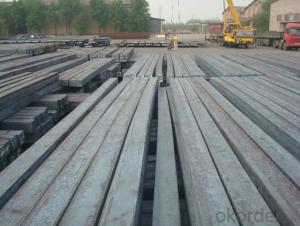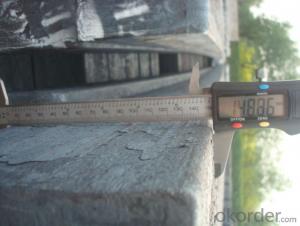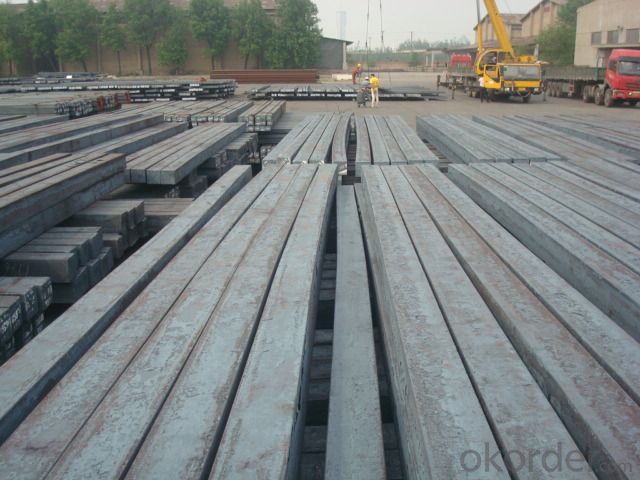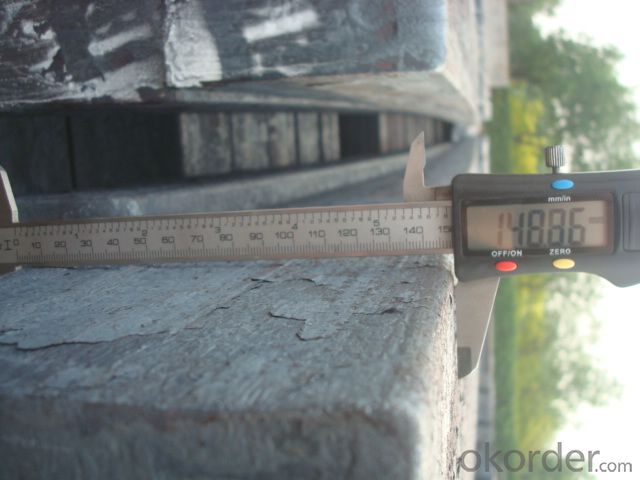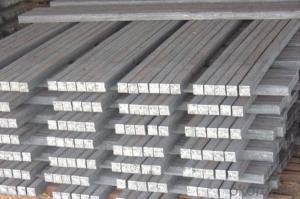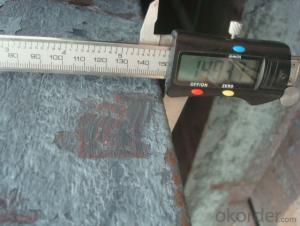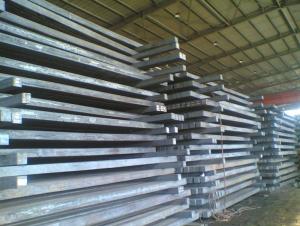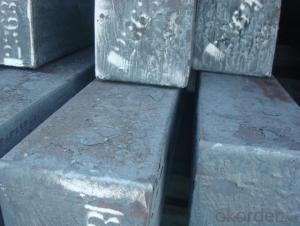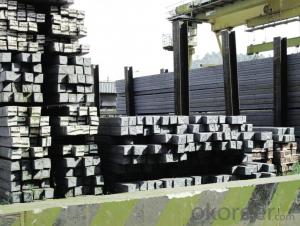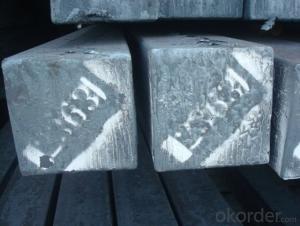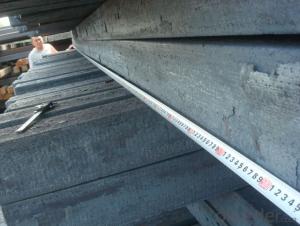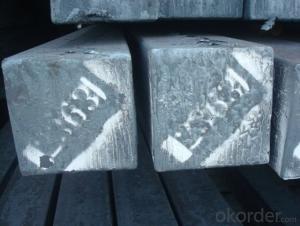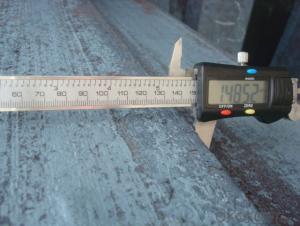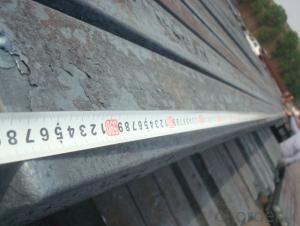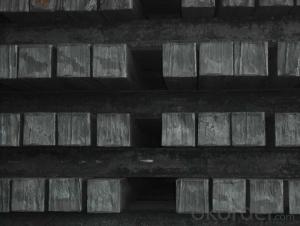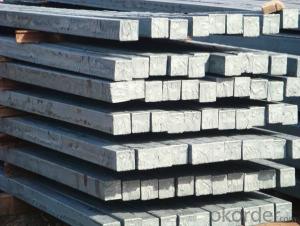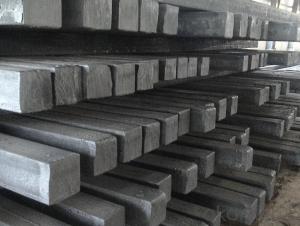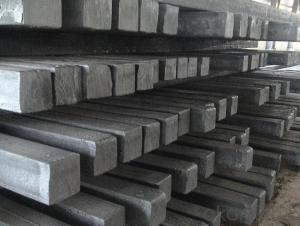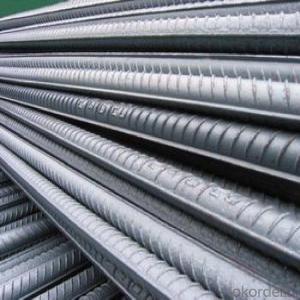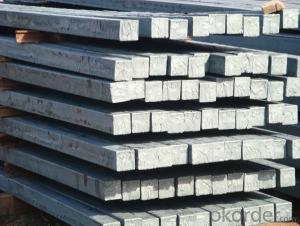Continue Casting Steel Billets Manufactured By Blasting Furnace
- Loading Port:
- Qingdao
- Payment Terms:
- TT OR LC
- Min Order Qty:
- 1000 m.t.
- Supply Capability:
- 10000 m.t./month
OKorder Service Pledge
OKorder Financial Service
You Might Also Like
Continue Casting Steel Billets Manufactured By Blasting Furnace
1.Structure of Continue Casting Steel Billets Manufactured By Blasting Furnace
Continue Casting Steel Billets Manufactured By Blasting Furnace is the raw material of all kinds of steel mill. Billet section of square, round, flat, rectangular and abnormity, etc Several, mainly related to shape of rolled products. Simple rolled section steel, choose cross section of square billet or rectangular billet. rolling The sector products such as flat steel, Angle steel, select the rectangular billet or slab. Had better profiled billet when production beams, channels, and in rolling process Lines and improve the yield. The raw material of round billet is the production of seamless tube.
2.Main Features of Continue Casting Steel Billets Manufactured By Blasting Furnace.
Continue Casting Steel Billet Manufactured By Blasting Furnace section size should meet the requirements of rolling deformation and finished product quality, but also roll strength and biting condition of restrictions. General steel Billet section height H. And the roll diameter D The ratio of the ( namely H/D) Should be less than or equal to zero 0.5 . Length of steel billet by finishing temperature, Rolling time and the length of the product Or times ruler. When heated too long accident prone to bump the furnace wall of steel, too short, furnace bottom utilization rate is not high, influence the heating furnace production. For the production Choose a variety of steel and steel billet, should consider the affinities of billet, as far as possible in order to improve the productivity of the roughing mill, simplify the stock management of workshop.
3. Continue Casting Steel Billets Manufactured By Blasting Furnace Images
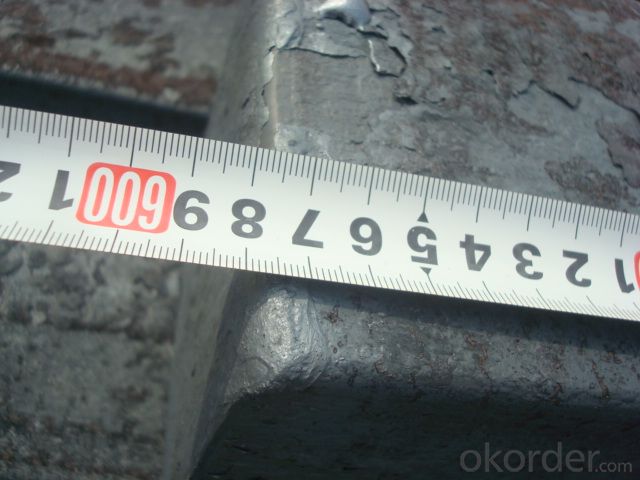
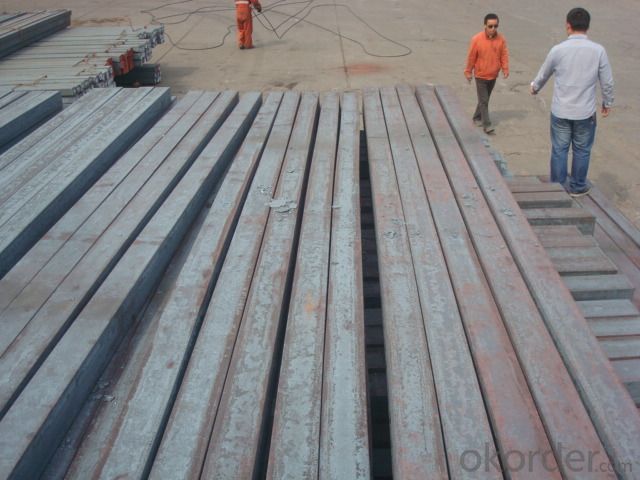
4. Continue Casting Steel Billets Manufactured By Blasting Furnace Specification
Continue Casting Steel Billet Manufactured By Blasting Furnace rolled steel, after processing can be used for mechanical parts, forging parts, processing all kinds of steel, steel Q345B channel steel, wire rod is the role of the billet. Steel billet is used in the production of semi-finished products, generally cannot be used directly for the society. Steel billets and steel are strictly divided into standard, cannot decide to whether the business enterprise of the final product, and according to unified standards to perform the whole society. Typically, billet and the steel is relatively easy to distinguish, but for some steel billet, and have the same specification and same steel purposes (such as rolling tube billet), whether can be used for other industries, whether through steel processing process, whether through a finished product rolling mill processing to distinguish
Material standard The editor Range of thickness: 150-240 - mm + / - 5 mm width range: 880-1530 - mm + / - 20 mm Length: 3700-10000 - mm + / - 500 - mm Cross-sectional size: 64 * 64; 82 * 82; 98 * 98; 124 * 124; 120 * 150; 152 * 164; 152 * 170 mm Length: 9000 mm Section of tolerance: billet: 1.0 + / - 2.0-1.0 + / - 1.0 mm slab: width: + / - 2.0 mm thickness: + / - 3.0 mm The length tolerance: + / - 200 mm Section diagonal tolerance: 3.5-8.0 MM Billet section size protrusions requirements: < 1242 mm, do not allow; > = 1242 mm, < = 2 mm 1242 mm, < = 3 mm Beheading (shear) extension deformation: < 1242 mm billet: no control; The slab: < = 15 mm Surface tilt: no more than billet section 0.1 Bending: every 1 m length is not more than 10 mm The distortion: length < = 5 m, < = 11. ; The length of the < = 7.5 M, < = 5. Material % 3 sp/PS chemical composition: C Mn Si S P
There are three shapes of the steel billets: square billet, slab, rectangular billet The Chinese billet, rectangular billet is mainly suitable for rolling hot rolled strip, building reinforced bar, Ordinary wire, high speed wire rod and various small profile. Of the slab are mainly used for rolling plate and hot coil sheet.
5.FAQ of Continue Casting Steel Billets Manufactured By Blasting Furnace
We have organized several common questions for our clients,may help you sincerely:
①How could we get the quotation by internet?
You can send you inquiry through our website: www.okorder.com or you can email to me dirrectly.
②What about the quality certificate report?
We will send you the original quality certificate from the steel mill.
③How about your facotry's annual capacity?
Our capacity is about 1000,000tons, and if you need more we can supply to you too.
- Q: How are steel billets packaged for shipment?
- Steel billets are typically packaged for shipment by placing them on wooden pallets or in steel cages. They are then secured using steel strapping or shrink wrap to prevent movement or damage during transportation. Labels are also attached to the packaging to identify the type, quantity, and destination of the billets.
- Q: How are steel billets used in the manufacturing of shafts?
- Steel billets are used in the manufacturing of shafts as the starting material. The billets are heated and then shaped and machined into the desired shape and size of the shaft. This process ensures that the shafts are strong, durable, and able to withstand the required loads and stresses in various applications.
- Q: What are the different methods of surface treatment for steel billets?
- Some of the different methods of surface treatment for steel billets include shot blasting, pickling, galvanizing, painting, and powder coating.
- Q: How are steel billets used in the manufacturing of oil and gas industry components?
- The oil and gas industry heavily relies on steel billets, which are a necessary raw material for manufacturing various components. These semi-finished steel products have a vital role in producing pipes, valves, fittings, and other necessary equipment for oil and gas extraction, transportation, and processing. One primary application of steel billets in the oil and gas industry is their use in producing seamless and welded pipes. These pipes are extensively used for transporting oil, gas, and fluids over long distances. To form seamless pipes, the billets undergo heating and then pass through a series of rollers. For welded pipes, the billets are initially shaped into a tube and then welded along the length to create a strong and durable pipe. In addition to pipes, steel billets are also used in manufacturing valves, which play a crucial role in controlling fluid flow within pipelines and equipment. The billets are machined and shaped to create valve bodies, which are then fitted with various internal components like seats, discs, and stems. These valves are designed to withstand high pressures and temperatures, ensuring reliable and safe operation in the oil and gas industry. Moreover, steel billets are utilized in producing fittings that connect and join pipes together. Elbows, tees, couplings, and flanges are manufactured from billets by machining and shaping them into the required dimensions and configurations. These fittings are critical for creating a dependable and leak-free pipeline system for oil and gas transportation. Apart from pipes, valves, and fittings, steel billets also have applications in manufacturing other equipment used in the oil and gas industry. This includes drill bits, pumps, compressors, and various structural components for offshore platforms and refineries. The strength, durability, and corrosion resistance of steel make it an ideal material for these demanding applications, and steel billets serve as the starting point for their production. In conclusion, steel billets are of utmost importance as a raw material for manufacturing components in the oil and gas industry. Whether it is pipes, valves, fittings, or other equipment, billets undergo various processes to create the essential components needed for oil and gas extraction, transportation, and processing.
- Q: What are the different types of steel billet shearing techniques?
- There are several types of steel billet shearing techniques, including guillotine shearing, rotary shearing, and flying shear.
- Q: What are the potential applications of steel billets in the mining industry?
- The mining industry can benefit greatly from the versatile uses of steel billets. Firstly, these billets can be shaped and welded to create various components for mining equipment and machinery. Frames, supports, and chassis for heavy machinery can all be constructed using steel billets due to their strength and durability. This allows them to withstand the harsh conditions and heavy loads encountered in mining operations. Secondly, steel billets are ideal for fabricating conveyor belts, which are essential for transporting bulk materials in mines. The high tensile strength of steel ensures that the conveyor belts can handle the weight of the materials being transported, as well as the constant movement and impact involved in the mining process. Furthermore, steel billets can be utilized in constructing underground support systems, such as mine shafts and tunnels. These structures require reliable and robust materials to ensure the safety of workers and the integrity of the mining operation. Steel billets can be used to manufacture support beams, rods, and plates, providing the necessary stability and reinforcement. In addition, steel billets are valuable in producing wear-resistant components crucial in mineral processing, such as grinding balls and liners. These components are used in grinding mills to crush and grind ore, and steel's abrasion-resistant properties make it an ideal material for this purpose. By incorporating steel billets, mining companies can enhance the efficiency and longevity of their mineral processing operations. Overall, steel billets have a wide range of potential applications in the mining industry. From manufacturing equipment and fabricating conveyor belts to constructing underground support systems and producing wear-resistant components, steel billets contribute significantly to improving the productivity, safety, and efficiency of mining operations.
- Q: What are the different surface treatments for improved surface hardness in steel billets?
- To enhance the surface hardness of steel billets, there are various surface treatments available. These treatments aim to increase the wear resistance and durability of the steel, making it suitable for a range of industrial uses. One frequently used method is carburizing, which involves exposing the steel billet to a carbon-rich environment, like methane or propane. This process introduces carbon into the surface, creating a hard layer called a case that significantly boosts the billet's surface hardness. Another technique is nitriding, where the steel billet is exposed to a nitrogen-rich atmosphere at elevated temperatures. This causes nitrogen atoms to diffuse into the surface, forming a hard nitride layer. Nitriding not only enhances surface hardness but also improves resistance to wear and corrosion. Induction hardening is a third method that utilizes electromagnetic induction to rapidly heat the steel billet's surface. After reaching the desired temperature, the billet is quickly cooled, resulting in a hardened surface layer. This treatment is especially effective for localized hardening of specific areas. Furthermore, shot peening is a surface treatment that involves bombarding the steel billet's surface with small, high-velocity steel shots. This process induces compressive stresses in the surface layer, thereby increasing hardness and fatigue resistance. Each of these surface treatments comes with its own advantages and disadvantages. The choice of treatment method depends on the specific requirements and intended use of the steel billets. By selecting the appropriate surface treatment, manufacturers can ensure that the steel billets possess the necessary hardness and durability for their intended applications.
- Q: Are steel billets subject to any regulations or certifications?
- Steel billets must adhere to numerous regulations and certifications to guarantee their production, quality, and safety standards are met. The ISO 9001 certification, an internationally recognized standard for quality management systems, is one of the most common certifications for steel billets. This certification ensures that the manufacturing process of steel billets follows consistent quality control measures, from sourcing raw materials to final production. Steel billets may also need to obtain industry-specific certifications, depending on their intended use. For example, if the steel billets are intended for construction projects, they must comply with certifications such as ASTM standards or European EN standards. These certifications define the necessary mechanical properties, chemical composition, and other specifications that steel billets must meet to ensure they are suitable for construction purposes. In addition, governmental bodies or industry associations may impose regulations on steel billets. These regulations can include safety standards, environmental regulations, and compliance with trade policies. For instance, steel billet producers may need to comply with regulations regarding emissions, waste management, or occupational health and safety. In conclusion, various regulations and certifications are in place to ensure the quality, safety, and compliance with industry standards of steel billets. These certifications and regulations are crucial for maintaining the integrity of steel billets and ensuring they are suitable for various applications.
- Q: What are the international standards or certifications for steel billets?
- The international standards or certifications for steel billets include ASTM A615/A615M-20, ASTM A706/A706M-16, BS 4449:2005+A3:2016, and EN 10025-2:2004. These standards provide specifications for the chemical composition, mechanical properties, and dimensions of steel billets, ensuring their quality and suitability for various applications in the construction industry.
- Q: What are the different shapes and sizes of steel billets?
- Steel billets come in various shapes and sizes, including square, round, rectangular, and hexagonal. The sizes of steel billets can range from small dimensions, such as 100mm x 100mm, to larger dimensions, such as 400mm x 400mm. These different shapes and sizes of steel billets serve different purposes and can be used in various industries, including construction, manufacturing, and automotive.
Send your message to us
Continue Casting Steel Billets Manufactured By Blasting Furnace
- Loading Port:
- Qingdao
- Payment Terms:
- TT OR LC
- Min Order Qty:
- 1000 m.t.
- Supply Capability:
- 10000 m.t./month
OKorder Service Pledge
OKorder Financial Service
Similar products
Hot products
Hot Searches
Related keywords
